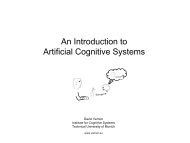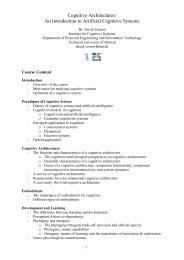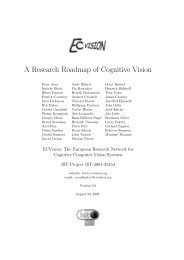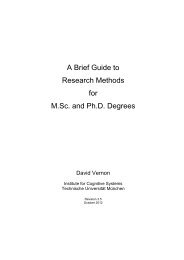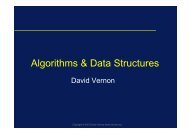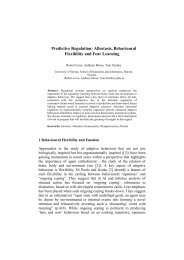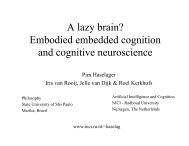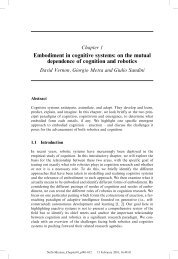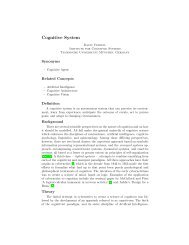Dynamic Field Theory (DFT): Applications in Cognitive Science and ...
Dynamic Field Theory (DFT): Applications in Cognitive Science and ...
Dynamic Field Theory (DFT): Applications in Cognitive Science and ...
You also want an ePaper? Increase the reach of your titles
YUMPU automatically turns print PDFs into web optimized ePapers that Google loves.
In the follow<strong>in</strong>g we briefly discuss representative examples that shall illustrate<br />
the basic concepts of <strong>DFT</strong> <strong>and</strong> its application <strong>in</strong> different cognitive doma<strong>in</strong>s (for a<br />
recent survey of the mathematical treatment see [5]). As embodied validations of the<br />
approach, we <strong>in</strong>clude studies <strong>in</strong> which autonomous robots were endowed with some<br />
cognitive capacities such as decision mak<strong>in</strong>g, memory, action underst<strong>and</strong><strong>in</strong>g or<br />
anticipation. The reader is encouraged to visit the orig<strong>in</strong>al publications for proper<br />
treatment.<br />
Basic concepts<br />
<strong>Dynamic</strong> fields are def<strong>in</strong>ed over metric dimensions that <strong>in</strong> most applications reflect<br />
parameters of the experimental setup such as for <strong>in</strong>stance visual space, object features or<br />
movement parameters. A localized peak of activation with<strong>in</strong> the field represents metric<br />
<strong>in</strong>formation about the underly<strong>in</strong>g dimension. In analogy to the concept of neural<br />
population cod<strong>in</strong>g, the localized peak may be <strong>in</strong>terpreted as the activation pattern of a<br />
pool of neighbour<strong>in</strong>g neurons with similar tun<strong>in</strong>g properties <strong>in</strong> an otherwise <strong>in</strong>active<br />
population [8]. The peak evolves under the <strong>in</strong>fluence of time-dependent external <strong>in</strong>put<br />
but is ma<strong>in</strong>ly shaped by the recurrent <strong>in</strong>teractions with<strong>in</strong> the population. Due to the<br />
<strong>in</strong>teractions the peak is self-susta<strong>in</strong>ed <strong>and</strong> may thus serve to memorize <strong>in</strong>formation.<br />
However, <strong>in</strong> order to perform a work<strong>in</strong>g memory the field dynamics has to be bi-stable.<br />
The attractor state of a persistent fir<strong>in</strong>g pattern coexists with a stable homogenous<br />
activation distribution that represents the absence of <strong>in</strong>formation. A sufficiently strong<br />
transient <strong>in</strong>put specify<strong>in</strong>g a particular <strong>in</strong>stance of the metric dimension is able to<br />
“switch on” the memory function by destabiliz<strong>in</strong>g the uniform rest state. A suitable<br />
<strong>in</strong>hibitory signal, on the other h<strong>and</strong>, may destabilize the excited state, result<strong>in</strong>g <strong>in</strong> a<br />
decay of activation back to rest<strong>in</strong>g state. The critical parameter that decides whether or<br />
not the uniform state becomes unstable is <strong>in</strong>put strength. Below a certa<strong>in</strong> threshold,<br />
<strong>in</strong>homogeneous solutions of the field dynamics exist that are ma<strong>in</strong>ly <strong>in</strong>put driven. In<br />
many applications this regime is exploited to represent for <strong>in</strong>stance ambiguous prior<br />
<strong>in</strong>formation about the dimension spanned by the field. Much like prior distributions <strong>in</strong><br />
the Bayesian sense, multi-modal patterns of subthreshold activation may encode the<br />
probability of choices [9].<br />
With<strong>in</strong> the <strong>DFT</strong> framework, the existence of a memory function is closely l<strong>in</strong>ked<br />
to decision mak<strong>in</strong>g. A self-susta<strong>in</strong>ed activation peak is the result of the <strong>in</strong>terplay<br />
between excitatory <strong>and</strong> <strong>in</strong>hibitory forces with<strong>in</strong> the field. Excitatory <strong>in</strong>teractions<br />
between neighbour<strong>in</strong>g neurons are counterbalance by lateral <strong>in</strong>hibition. S<strong>in</strong>ce <strong>in</strong>hibitory<br />
<strong>in</strong>teractions dom<strong>in</strong>ate at larger distances, a competition process takes place whenever<br />
two or more suprathreshold <strong>in</strong>puts are simultaneously applied. At the field site that<br />
<strong>in</strong>tegrates the highest level of sensory or other evidence a s<strong>in</strong>gle activation peak will<br />
emerge. It suppresses the activation elsewhere <strong>in</strong> the field below rest<strong>in</strong>g level. Once the<br />
stable attractor state has been reached, the decision represented by the peak location is<br />
protected aga<strong>in</strong>st noise <strong>and</strong> fluctuations <strong>in</strong> the <strong>in</strong>put stream. This does not mean,<br />
however, that the peak is completely immune aga<strong>in</strong>st change. Localized <strong>in</strong>put that<br />
spatially overlaps with the peak position causes the peak to drift <strong>in</strong> the direction of this<br />
<strong>in</strong>put. Mathematically, the attractor can be described as be<strong>in</strong>g cont<strong>in</strong>uous along the<br />
dimension spanned by the field. This property of the field dynamics has been exploited<br />
for <strong>in</strong>stance to expla<strong>in</strong> <strong>and</strong> apply the capacity of track<strong>in</strong>g time-vary<strong>in</strong>g <strong>in</strong>put <strong>in</strong> real time<br />
([10], [11]).<br />
Although the formation of spatially localized peaks is certa<strong>in</strong>ly the backbone of<br />
most <strong>DFT</strong>-based models thus fare, it is important to note that the field dynamics - if<br />
properly tuned - may exhibit other types of self-organiz<strong>in</strong>g patterns (e.g., .travell<strong>in</strong>g





